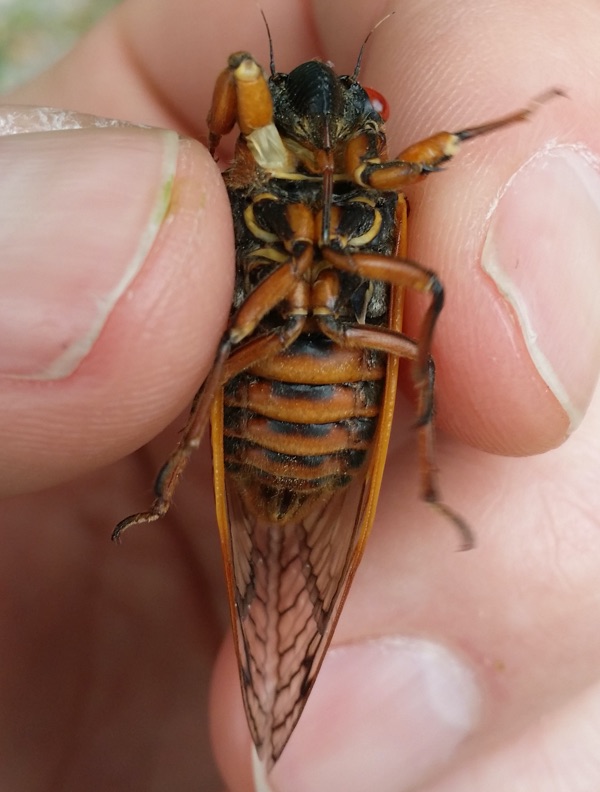Magicicada neotredecim Marshall and Cooley, 2000.

Song type: Call
Source: ©Insect Singers | Species: M. neotredecim
Video Playlist
Playlists contain multiple videos found on YouTube.
Identification Tips
Thick orange stripes on the abdomen. Orange between the eye and wing insertion. In the few areas it overlaps with M. tredecim, M. neotredecim sings with a higher pitch. Read more on Cicadas @ UCONN (formerly Magicicada.org). It is similar to the 17-year species M. septendecim.
Brood Chart
Magicicada neotredecim has a 13-year life cycle.
Brood XIX (19)
XIX (19)
Years: 1972, 1985, 1998, 2011, 2024
Locations: AR, IL, IN, KS, KY, MO, OK
XXIII (23)
XXIII (23)
Years: 1976, 1989, 2002, 2015, 2028
Locations: AR, IL, IN, KY, MO
Name, Location and Description
- Cicada Name: Magicicada neotredecim Marshall and Cooley, 2000
- Short Name: M. neotredecim
- Common Name: 13 Periodical Cicada or 13-Year Cicada
- When: May-June. Peak in June. Every 13 years.
- Where it is found: AR, IA, IL, IN, KY, MO, TN
- Maps: Map
- Description: Black body with orange wings and legs. Orange stripes on abdomen. Orange between eye and wing.
- Eye Color: reddish orange
- Pronotal Collar Color: black
- Identification: Bug Guide
- Subject Matter Expert website: Cicadas @ UCONN (formerly Magicicada.org)
- Taxonomic Information: Integrated Taxonomic Information System
- Song: Cicadas @ UCONN (formerly Magicicada.org)
Classification:
Family: Cicadidae
Subfamily: Cicadettinae
Tribe: Lamotialnini
Subtribe: Tryellina
Genus: Magicicada
Species: Magicicada neotredecim Marshall and Cooley, 2000
List of sources
- Full Binomial Names: ITIS.gov
- Common names: BugGuide.net; The Songs of Insects by Lang Elliott and Wil Herschberger; personal memory.
- Locations: Cicadas @ UCONN (formerly Magicicada.org).
- Descriptions, Colors: personal observations from specimens or photos from many sources. Descriptions are not perfect, but may be helpful.
- Tribe information comes from: MARSHALL, DAVID C. et al.A molecular phylogeny of the cicadas (Hemiptera: Cicadidae) with a review of tribe and subfamily classification.Zootaxa, [S.l.], v. 4424, n. 1, p. 1—64, may 2018. ISSN 1175-5334. Available at: https://www.biotaxa.org/Zootaxa/article/view/zootaxa.4424.1.1
Notes:
- Some descriptions are based on aged specimens which have lost some or a lot of their color.
2 replies on “Magicicada neotredecim Marshall and Cooley, 2000”
I heard Neos with their high pitch son in Dixon Springs and Shawnee Natl IL 2024 if anyone is tracking the neo locations.
Last month noticed a big bug similar to a grasshopper, but bigger. This year I’ve killed at least eight or nine. Smaller ones were gray with orange on their back. The most are very large, yellow.I kept two of the latest in a glass jar. I was viewing a local Television station this morning when they talked about the cicada bug in South America that were in the ground since 1700. I’ve heard wild things on TV, so I searched this web site. I read where the cicada does change colors. I’m eighty six years of age. Trying to keep busy through this “stay at home” time, and working in my yard that I sit each morning with a cup of coffee. Nothing crawls around my home… but ME.